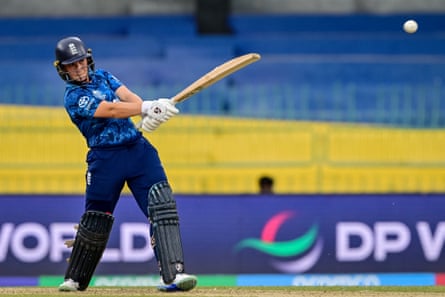England find themselves in a curious position at the halfway point of their World Cup campaign as they prepare to face the hosts, India, on Sunday. They are unbeaten, sit third in the points table, and – partly because India have already lost twice – have a 98% chance of qualifying for the semi-finals. One more win would seal their progress to the knockouts.
Yet their batting has been woeful. With the honourable exception of Nat Sciver-Brunt, England’s top seven have looked desperately lacking in the technique and temperament that is required on tricky batting tracks at Guwahati and Colombo. Without Sciver-Brunt’s century against Sri Lanka, England’s total would have been a mere 136 and they would almost certainly have lost. On Wednesday they found themselves 78 for seven against Pakistan: they were saved from a historic maiden defeat against Fatima Sana’s team only by a well-timed deluge that forced an abandonment.
The numbers speak to quite how poor England’s batting has been. Aside from Sciver-Brunt and Heather Knight, no England batter makes it into the top 30 across all teams for this World Cup. The contributions of England’s Nos 5, 6 and 7 do not make for pretty reading: Sophia Dunkley has scores of 0, 18 and 11; Emma Lamb’s efforts have yielded 1, 13 and 4; while Alice Capsey has hit 20, 0 and 16.
England’s strike rate is not only below that of Australia and India, but also of New Zealand and South Africa, and their boundary percentage is only 8% – by contrast, Australia’s is up at 14%. In a tournament where the trend has been for teams to ramp up their scoring rate in the final 10 overs, England’s death-overs run rate is only 6.5 – Sri Lanka’s is 8.4. By any metric, England are struggling to compete.
Of late there has been a tendency to blame everything on England’s poor fielding, but that hasn’t been an issue at this World Cup. Yet their deep-seated problems with the bat have been overlooked. The legacy of the former head coach Jon Lewis continues to cast a long shadow over this team. Players such as the 21-year-old Capsey lost two years of crucial development at the hands of “Jon-ball” – a philosophy that dictated she should attack every ball in sight with no thought to playing it on its actual merits.

Lewis’s successor, Charlotte Edwards, has had only six months to try to reverse the damage – but, as this World Cup demonstrates, hers will be a long-term project. Her players are no longer playing Jon-ball – they’ve been told, firmly, to put those ideas in the bin where they belong – but they are now caught in two minds about what should replace it. Do I go forward or back? Do I defend or attack? That liminal space in the middle enables the opposition to march through and take wickets.
Will England make dramatic changes against India? The short answer is no. The longer answer is that they can’t, because Edwards selected a World Cup squad stacked with bowlers. The only back-up batter is Danni Wyatt‑Hodge, who might well join the XI on Sunday.
Edwards also has the option of rejigging the batting order, which instinctively feels misaligned. Requiring Lamb, who has opened for years for Lancashire, to adopt a new role at No 6 is unfair. There is a strong case for her to open against India in place of Jones. Similarly, Capsey might well do better if trusted to bat in her natural position at No 3 – Knight has enough experience to adjust to slotting in lower down.
after newsletter promotion
There is also a good argument for promoting Charlie Dean, after solid scores of 27 not out against Bangladesh and 33 against Pakistan from No 8.
“Putting away high-risk options, trying to attack off the back foot where possible and be solid in defence,” was how Dean described her innings against Pakistan. If there is such a thing as Edwards-ball, this is the closest to a description of it.
The matches against Bangladesh, Sri Lanka and Pakistan were meant to be England’s “easy” games. They’ve been anything but. Now, with matches against India, Australia and New Zealand looming large, rain is unlikely to save England a second time. It’s time for the batters to have a go at doing that for themselves.

 4 hours ago
7
4 hours ago
7

















































